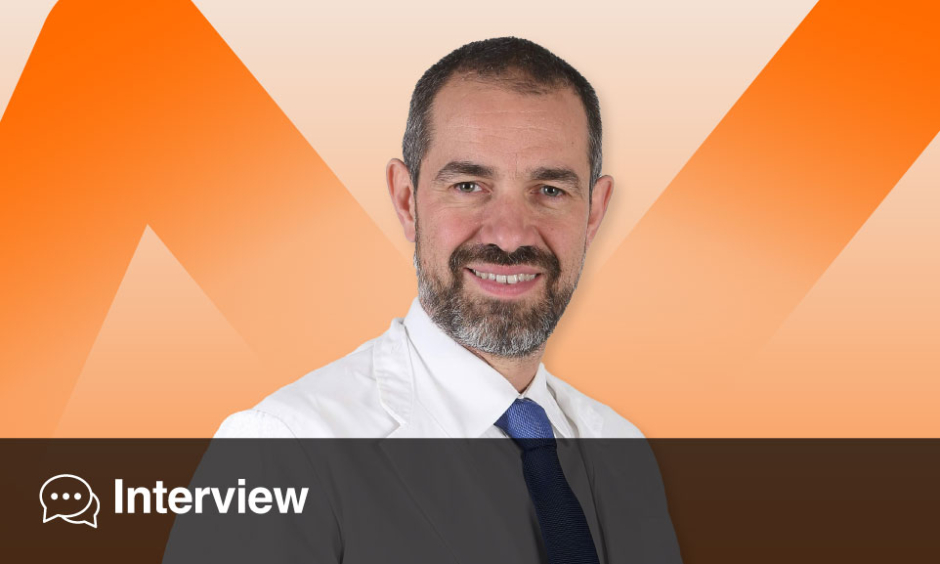Evangelos Liatsikos | Chair of EAU Education Office, European Association of Urology (EAU); Professor of Urology, Director of Urology Department, University Hospital of Patras, Greece
Citation: EMJ Urol. 2025;13[1]:66-68. https://doi.org/10.33590/emjurol/XVVE7552
![]()
Since our last interview in 2020, you have continued to shape the future of urology education and research. What have been your most fulfilling achievements in these past 5 years, and what future goals still drive your passion for the field?
First of all, I would like to highlight that this is actually teamwork! One of the key achievements we have made is the standardisation of education. This is not just my personal achievement but a collective effort by the team. We have standardised education at all levels, beginning with first-year residents and continuing through to senior urologists. Every single approach and procedure has been standardised in a highly proficient, competency-based way. This ensures that all individuals, from the younger residents to the most experienced professionals, have unlimited access to comprehensive training activities. It is important to highlight that our primary focus is on younger urologists, who stand to gain the most from access to these resources. It is our responsibility to train them, creating the future experts in the field.
As you chaired the joint European Association of Urology and Urological Society of Australia and New Zealand (EAU-USANZ) session on ‘Precision Medicine in Urologic Cancers’, how do you see AI and advanced imaging transforming the future of personalised treatmentsin urology?
I strongly believe that AI will transform medicine as a whole, totally revolutionising existing patterns. Significant advancements are made each year, not only in imaging but also in other aspects of our medical practice. The next few years will bring even more progress, whilst what we are currently witnessing is just the beginning. The integration of AI into existing surgical approaches, diagnostics, and treatment will significantly improve these fields. I am convinced that AI is crucial, and we must embrace it. Otherwise, we take the risk of losing the game and falling behind. For example, look how pilots now rely on autopilot systems even for landing. AI will act as the ‘autopilot’ in our medical practice, particularly in diagnostics and therapeutics. Moreover, AI is supposed to play a crucial role in automated surgeries like robotic procedures, where the machine is a significant intermediary between the surgeon’s hands and the operating field.
The thematic session you co-chaired on ‘Seminal Developments in Upper Tract Endoscopy’ spotlighted key advancements. What were the most exciting innovations in this field that urologists should be aware of?
Upper urinary tract endoscopy has seen remarkable developments and progress over the past years. For example, we now have scopes that are increasingly smaller, while at the same time offering exceptional image quality. Furthermore, recent advancements in laser technology have revolutionised the current management of stones and tumours. Moreover, improvements in inflow and outflow systems have allowed us to maintain constant pressure within the kidney. These developments are continuous, focusing on downsizing, image quality optimisation, development of more efficient lasers, and development of better monitoring systems to improve patient safety.
As Chair of the EAU Education Office, how do you ensure that the European School of Urology (ESU) continues to meet the evolving educational needs of urologists across Europe and beyond?
Let’s make something clear: our approach to education is driven by the needs of our stakeholders. We actively engage with them in order to understand their requirements. As you are already aware, our organisation is extensive, and various stakeholders, including national societies and all our members, communicate their needs to us. Following this communication, we assess their needs, and we adapt accordingly, striving to offer standardised treatments that can be implemented even in peripheral locations. This allows for a decentralised approach, with education being delivered at national societies and national meetings, ensuring global dissemination of knowledge.
The EAU is a highly influential organisation and one of the strongest and leading organisations in the field of urology worldwide. The EAU’s mission extends beyond the provision of scientific knowledge; it aims to foster a global network of professionals who can exchange both scientific insights and engage in social networking. I am proud to be a part of such a distinguished organisation.
With ESU activities spanning specialised e-courses, URO webinars, podcasts, and hands-on training, which recent initiatives do you believe have had the most impact on postgraduate education in urology?
The COVID-19 pandemic significantly accelerated the adoption of online education, as it was our only viable option during that period. This shift to online learning has proven to be highly effective and has become an integral part of our educational framework. Even surgical proctoring can now be conducted online. We offer a variety of educational formats, including webinars, e-courses, podcasts, and hands-on training, both remotely and at various sites. Whilst I don’t dwell on this, I recognise that the impact of the COVID-19 pandemic on the education system has been transformative, totally altering the current algorithm of education.
From your perspective, what have been the biggest highlights or standout sessions of this year’s Congress?
One of the major highlights of this year’s Congress was undoubtedly the live surgery session held on Saturday, where attendees had the opportunity to witness the latest urological developments in real-time. This is why the room was constantly filled with over 2,000 attendees throughout the day, demonstrating the value placed on these sessions. In addition, breakthrough research was presented at the EAU25 Congress, which was really intriguing. Overall, this year’s meeting has been a resounding success, with participants from all around the world. I think that at the end of the day, attendance reflects on how good or not a meeting is.
With your extensive experience in endourology and laparoscopy, looking ahead, what do you see as the next major breakthroughs in minimally-invasive urologic surgery, and how do you envision these advancements shaping patient care in the coming years?
The introduction of minimally-invasive surgery was a major revolution in the field of urology. Back in the days when we were residents, we were trained mainly in open surgery. However, open surgery is now becoming increasingly rare, especially in urology. We first transitioned to laparoscopy, followed by the use of scopes. Whilst these are distinct areas, significant progress has been made in both fields. One the one hand there’s the ‘endo’ part, which involves going through the lumen of the ureter and other organs. Scopes are becoming smaller and equipped with high-definition chips in their tips, improving image quality. Technology is doing very well! On the other hand is the laparoscopy and robotic surgery part, which is rapidly advancing. In the beginning, we had only one robotic company a couple of years ago. Now, we have another three that are Conformité Européenne marked, while multiple companies are expected to offer additional certified robotic systems in the near future. This technological evolution is optimisingsurgical practice.
I think that these advancements ultimately improve patient care in a significant way. For example, the use of machines in surgery enables us to standardise and objectively assess performance, as everything is recorded. Now, there are curricula that can evaluate the performance of the surgeon, while accreditation is based on a standardised, stepwise teaching methodology. And I believe that everything is, at the end of the day, for the benefit of our patients. For example, our instructors in the past used to say, “Big surgeon, big incision,” but that has now completely changed to, “The smaller incision, the better the surgeon.” The shift from the traditional notion of the ‘god-like’ surgeon performing large incisions to the modern approach, where smaller incisions are seen as a sign of greater skill, demonstrates the significant changes in the field. The focus is now on precision, minimising invasiveness, and improving patient outcomes.







